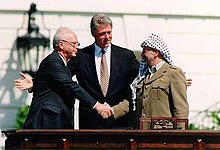Oslo Accords (1993)
In 1993, Israeli officials led by Yitzhak Rabin and Palestinian leaders from the Palestine Liberation Organization led by Yasser Arafat strove to find a peaceful solution through what became known as the Oslo peace process. A crucial milestone in this process was Arafat's letter of recognition of Israel's right to exist. In 1993, the Oslo Accords were finalized as a framework for future Israeli–Palestinian relations. The crux of the Oslo agreement was that Israel would gradually cede control of the Palestinian territories over to the Palestinians in exchange for peace. The Oslo process was delicate and progressed in fits and starts, the process took a turning point at the assassination of Yitzhak Rabin and finally unraveled when Arafat and Ehud Barak failed to reach agreement at Camp David in July 2000. Robert Malley, special assistant to US President Bill Clinton for Arab–Israeli Affairs, has confirmed that while Barak made no formal written offer to Arafat, the US did present concepts for peace which were considered by the Israeli side yet left unanswered by Arafat "the Palestinians’ principal failing is that from the beginning of the Camp David summit onward they were unable either to say yes to the American ideas or to present a cogent and specific counterproposal of their own".[12]Consequently, there are different accounts of the proposals considered.
Camp David Summit (2000)
Main article: 2000 Camp David Summit
In July 2000, US President Bill Clinton convened a peace summit between Palestinian leader Yasser Arafat and Israeli Prime Minister Ehud Barak. Barak reportedly put forward the following as 'bases for negotiation', via the U.S. to the Palestinian leader; 92% of the West Bank and the entire Gaza Strip,[16] as well as a Palestinian capital in East Jerusalem,[17] and that 69 Jewish settlements (which comprise 85% of the West Bank's Jewish settlers) would be ceded to Israel.[18] He also proposed "temporary Israeli control" indefinitely over another 10% of the West Bank territory—an area including many more Jewish settlements. According to Palestinian sources, the remaining area would be under Palestinian control, yet certain areas would be broken up by Israeli bypass roads and checkpoints. Depending on how the security roads would be configured, these Israeli roads might impede free travel by Palestinians throughout their proposed nation and reduce the ability to absorb Palestinian refugees.
Arafat rejected[16][19][20][21][22][23] this offer. According to the Palestinian negotiators the offer did not remove many of the elements of the Israeli occupation regarding land, security, settlements, and Jerusalem.[24] President Clinton reportedly requested that Arafat make a counter-offer, but he proposed none. Former Israeli Foreign Minister Shlomo Ben Ami who kept a diary of the negotiations said in an interview in 2001, when asked whether the Palestinians made a counterproposal: "No. And that is the heart of the matter. Never, in the negotiations between us and the Palestinians, was there a Palestinian counterproposal."[25]
No tenable solution was crafted which would satisfy both Israeli and Palestinian demands, even under intense US pressure. Clinton blamed Arafat for the failure of the Camp David Summit. In the months following the summit, Clinton appointed former US Senator George J. Mitchell to lead a fact-finding committee that later published the Mitchell Report aimed at restoring the peace process.
Developments following Camp David
Following the failed summit Palestinian and Israeli negotiators continued to meet in small groups through August and September 2000 to try to bridge the gaps between their respective positions. The United States prepared its own plan to resolve the outstanding issues. Clinton's presentation of the US proposals was delayed by the advent of the Second Intifada at the end of September.[24]
Clinton's plan, eventually presented on 23 December 2000, proposed the establishment of a sovereign Palestinian state in the Gaza strip and 94–96 percent of the West Bank plus the equivalent of 1–3 percent of the West Bank in land swaps from pre-1967 Israel. On Jerusalem the plan stated that, "the general principle is that Arab areas are Palestinian and that Jewish areas are Israeli." The holy sites were to be split on the basis that Palestinians would have sovereignty over the Temple Mount/Noble sanctuary, while the Israelis would have sovereignty over the Western Wall. On refugees the plan suggested a number of proposals including financial compensation, the right of return to the Palestinian state, and Israeli acknowledgement of suffering caused to the Palestinians in 1948. Security proposals referred to a "non-militarized" Palestinian state, and an international force for border security. Both sides accepted Clinton's plan and it became the basis for the negotiations at the Taba Peace summit the following January.[











0 komentar on Save Palestine :
Post a Comment and Don't Spam!